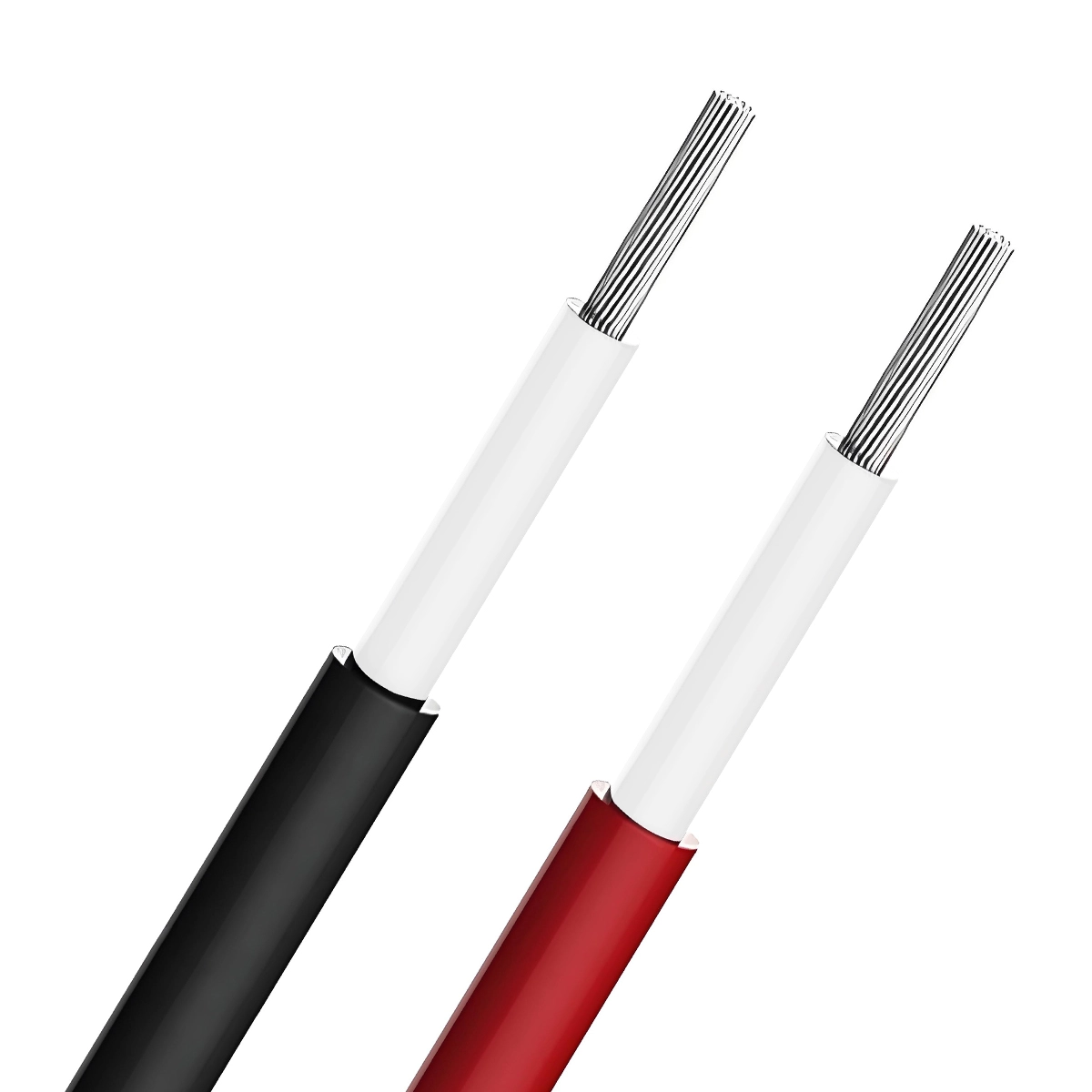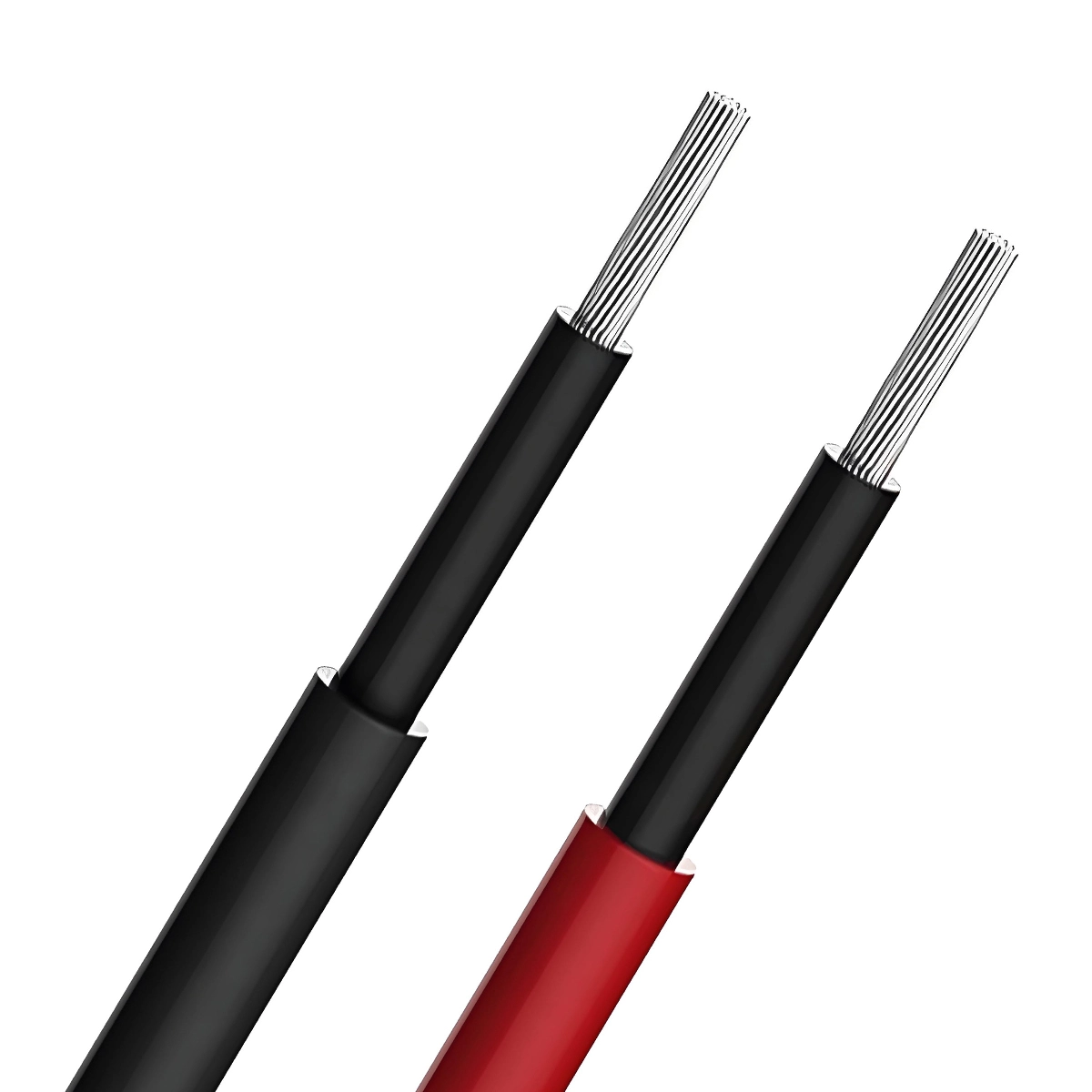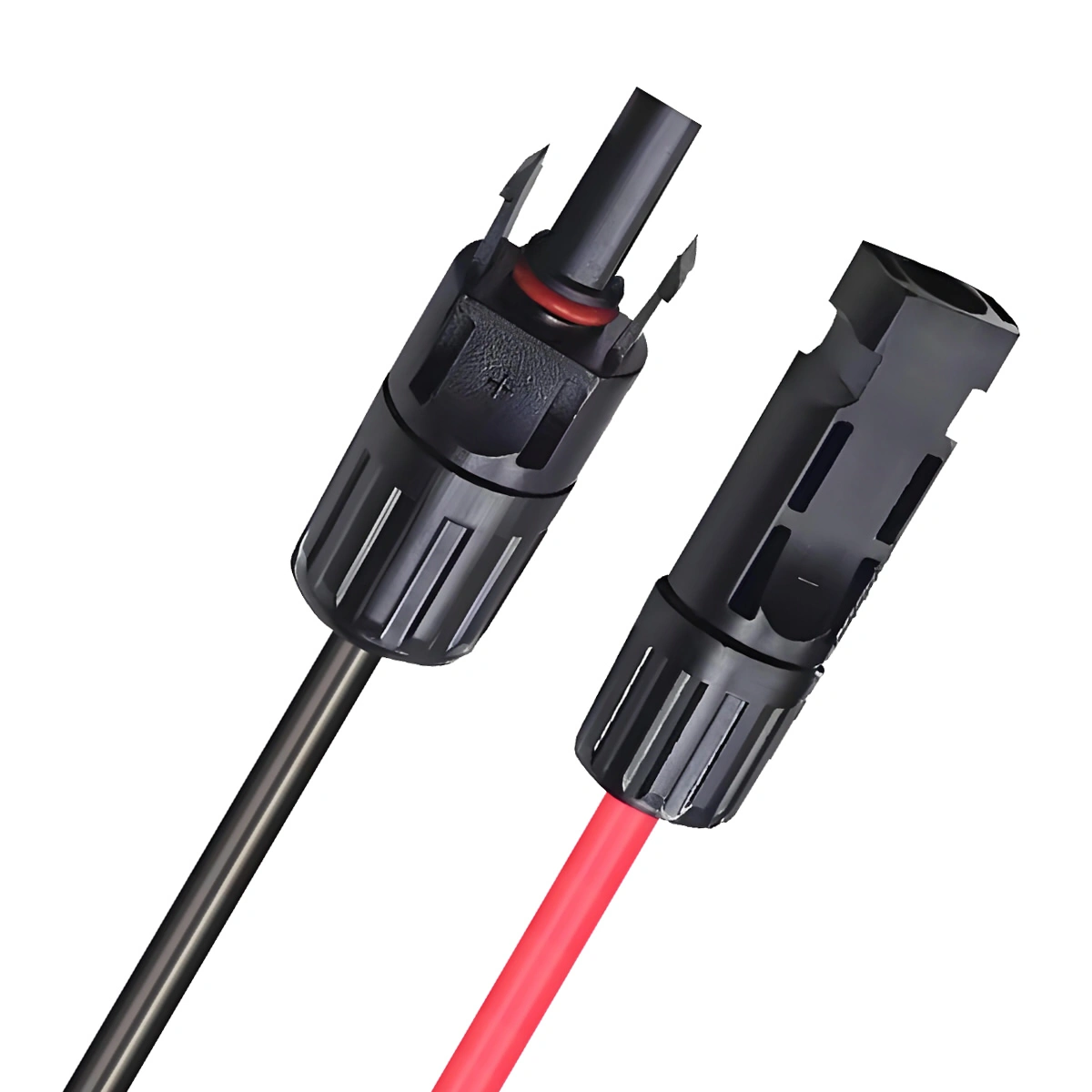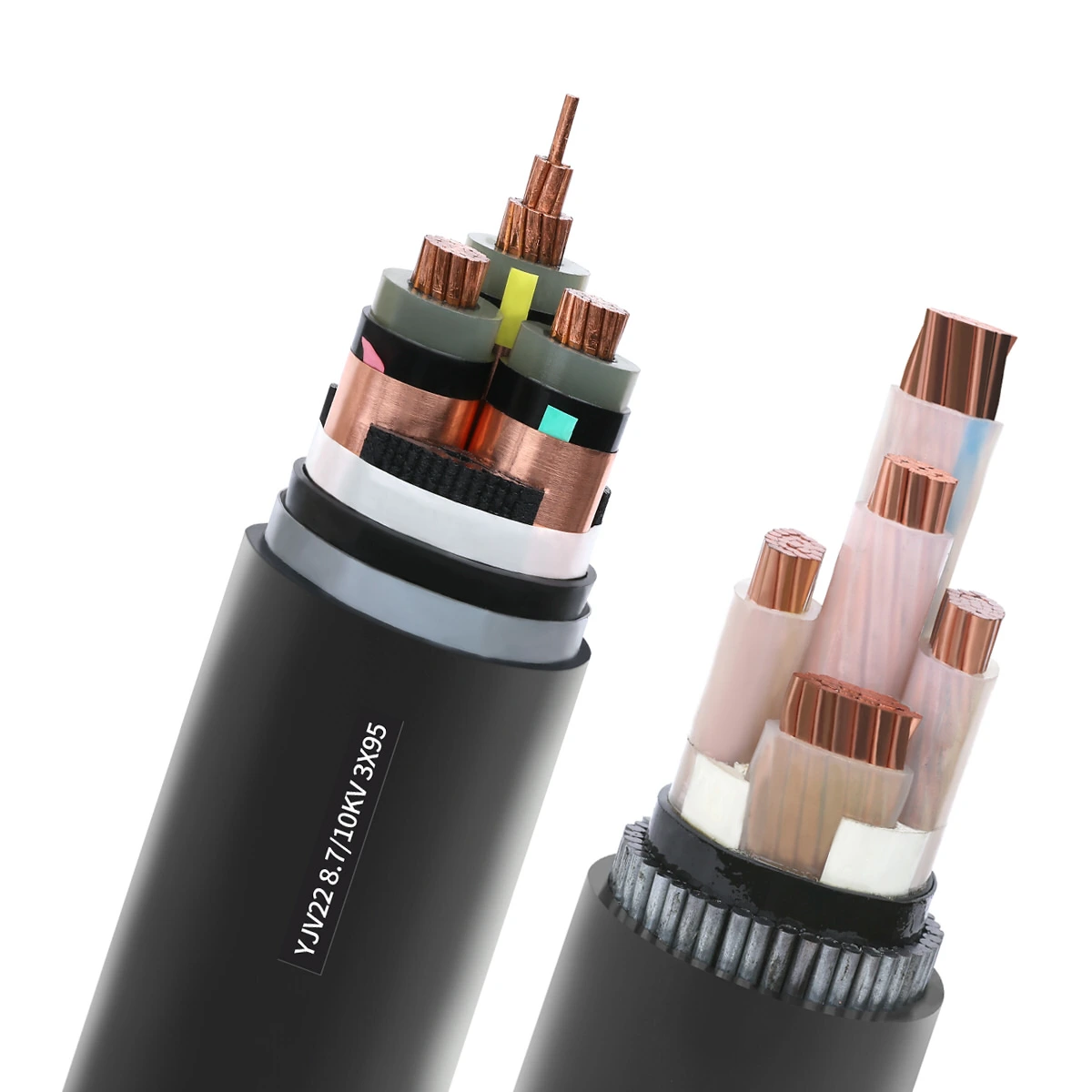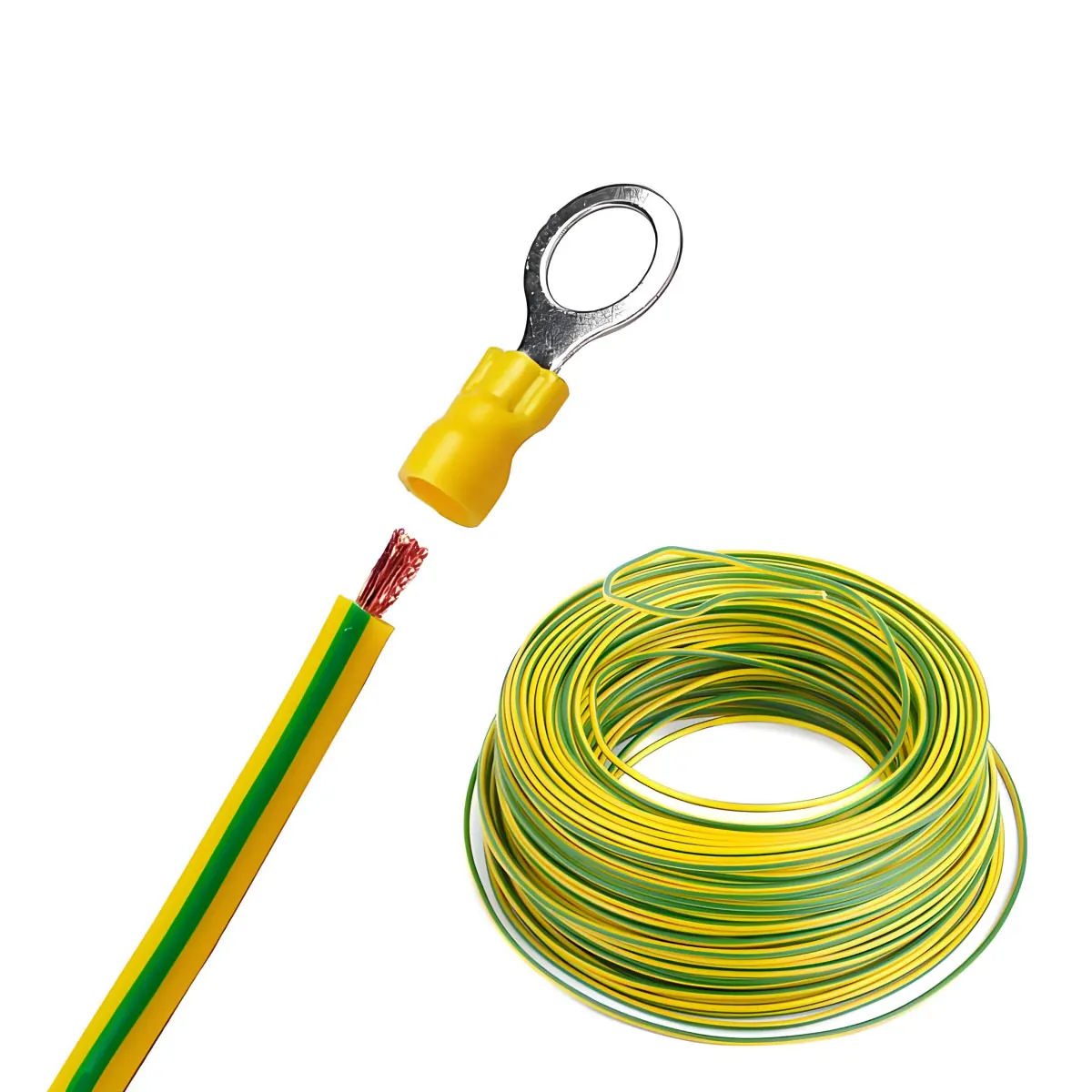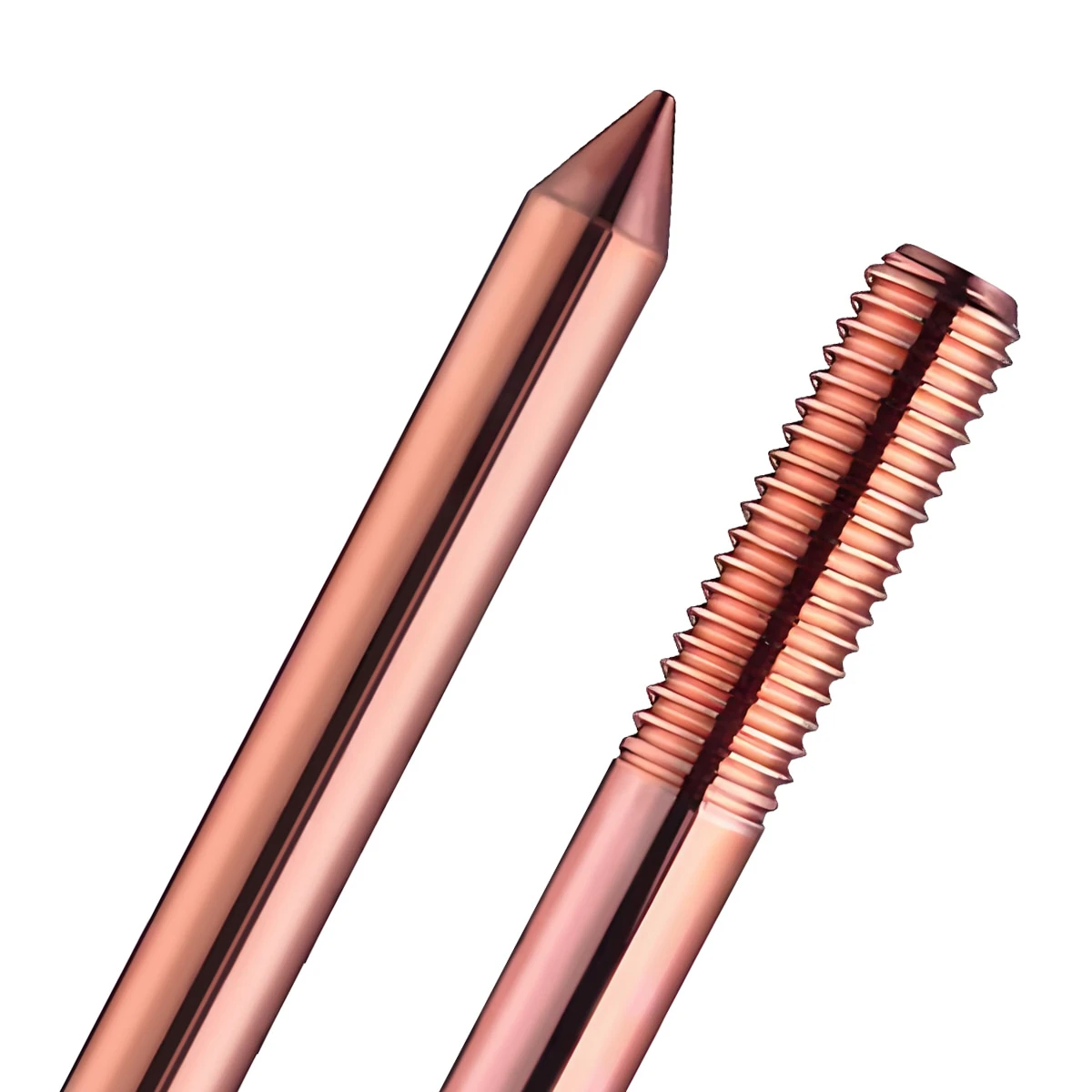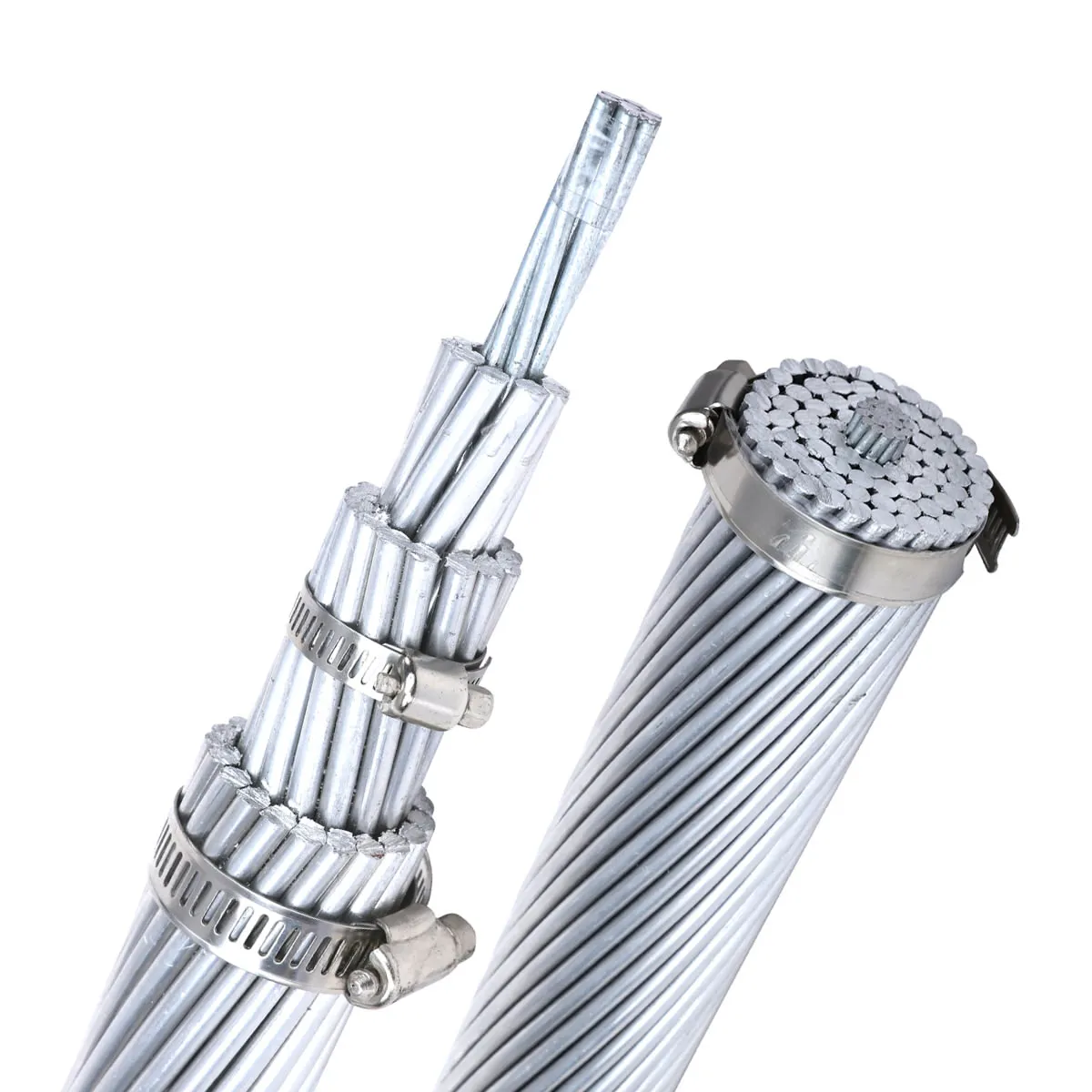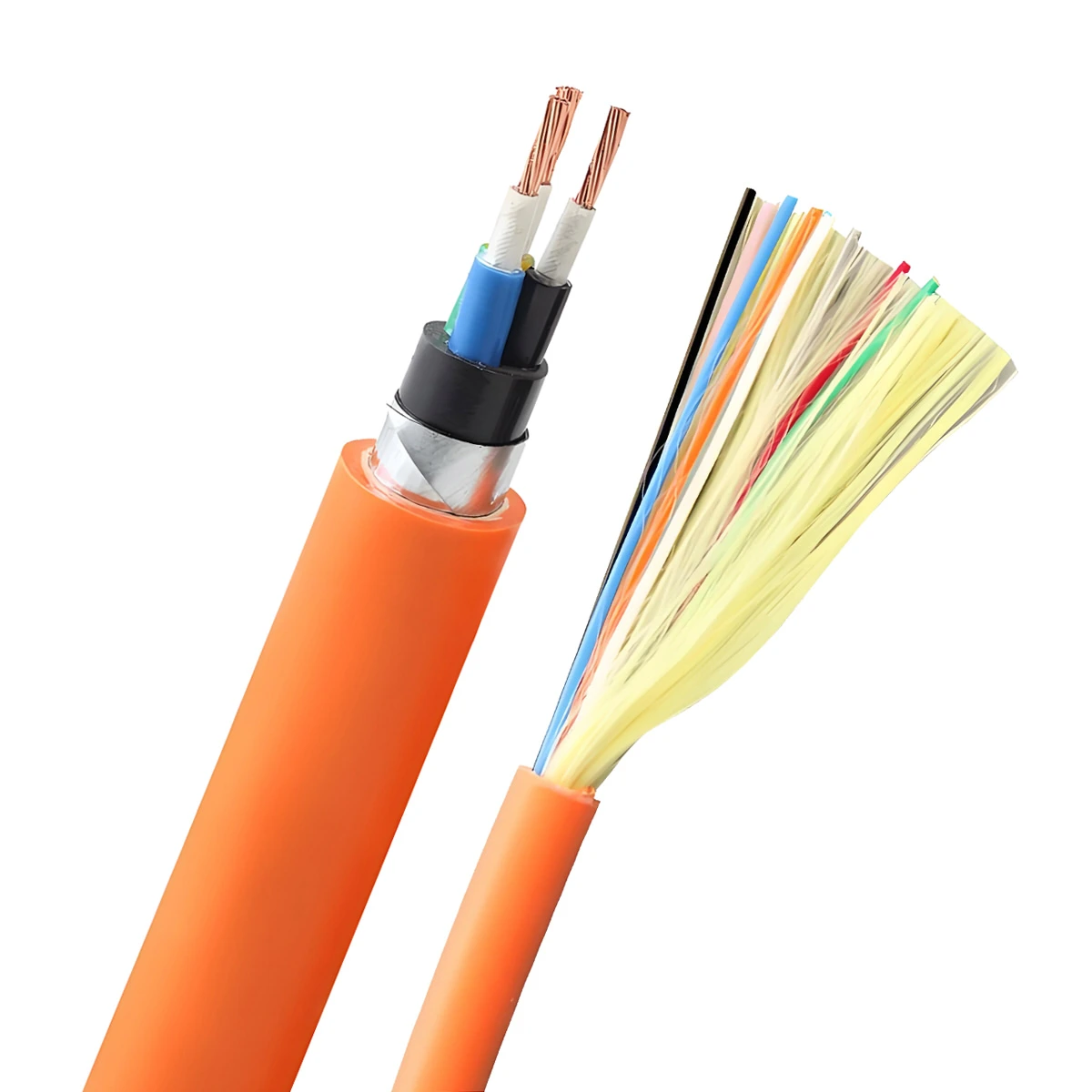Cabo PV1-F
Cabo PV1-F é usado principalmente para conectar componentes principais, como módulos fotovoltaicos, caixas combinadoras, inversores, e baterias em sistemas de geração de energia solar internos e externos.
O cabo ZMS PV1-F é irradiado profissionalmente para melhorar seu desempenho de isolamento e propriedades mecânicas. Pode atender aos requisitos específicos de aplicações fotovoltaicas para cabos, como resistência a altas temperaturas, Resistência UV, resistência ao ozono, e resistência à hidrólise.
Os cabos solares ZMS cumprem normas como EN 50618, BS EN 50396, e atender ao padrão de resistência UV HD 605/A1. Eles também são submetidos a testes de durabilidade de acordo com EN 60216 padrões. Nosso cabo solar PV1-F oferece alto custo-benefício para projetos de geração de energia fotovoltaica.
- Especificações: 1.5~150 mm²
- Padrão do produto: EM 50618
- Certificação de Produto: TÜV, CE, ISO
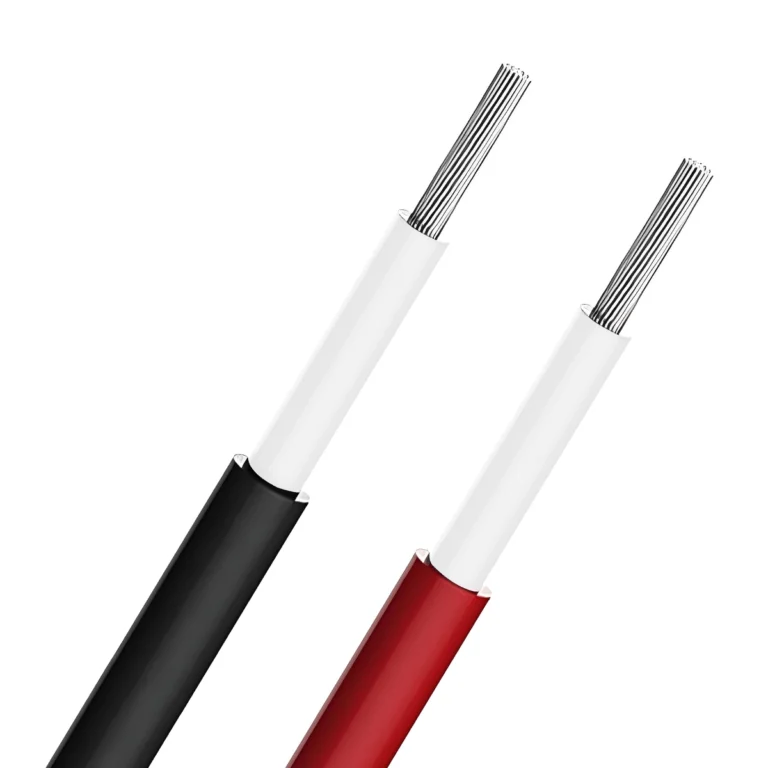
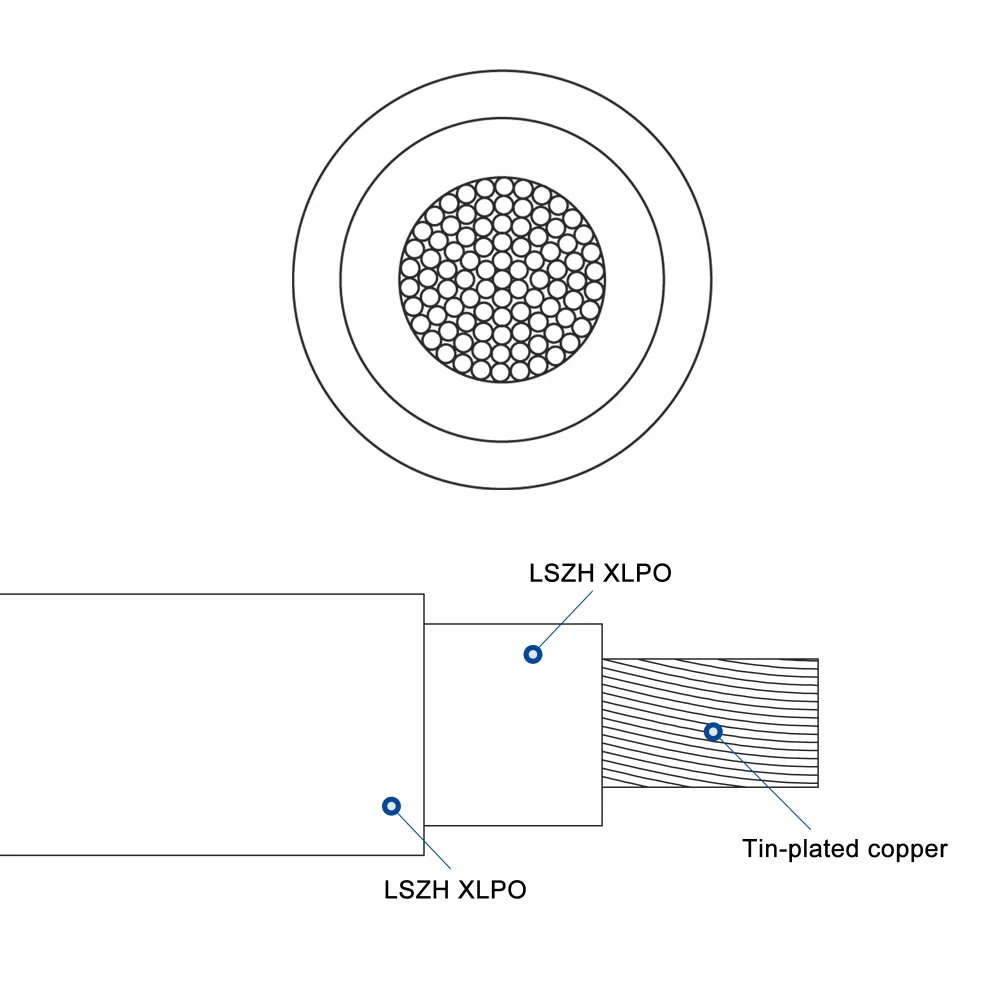
Parâmetros técnicos do cabo PV1-F
- Condutor: 99.9% Cobre estanhado
- Isolamento: Poliolefina reticulada irradiada com LSZH
- Bainha: Poliolefina reticulada irradiada com LSZH (preto e vermelho)
- Tensão nominal CA (Uo/U): 0.6/1kV
- Tensão nominal CC (Uo): 1.8kV (entre condutores, sistemas não aterrados)
- Tensão máxima do sistema (Um): 1.2kV
- Temperatura operacional do condutor: -45°C a +120°C
- Temperatura do ambiente operacional: -40°C a +90°C
- Temperatura de colocação de cabos: Não inferior a -25°C
- Classificação retardante de chama: CEI 60332-1
- Raio de curvatura mínimo: 5D (D: Diâmetro externo do cabo)
- Métodos de instalação: Colocação de conduíte, colocação de valas rasas, colocação de valas de cabos, colocação de túnel, colocação de sanduíche, colocação aérea apoiada, colocação aérea suspensa, etc..
- Vida útil: ≥25 anos
Certificação ZMS PV1-F

Ficha técnica PV1-F
| Modelo | Área Seccional Nominal (mm²) | Estrutura (milímetros) | Diâmetro Externo do Condutor (milímetros) | Diâmetro Externo do Cabo (milímetros) | 20°C Resistência DC do condutor (Ω/km) | Peso do cabo (kg/km) |
| PV1-F 1X1.5 | 1.5 | 30/0.25 | 1.5 | 4.98 | 13.7 | 40.69 |
| PV1-F 1X2,5 | 2.5 | 49/0.25 | 2.15 | 5.63 | 8.21 | 54.64 |
| PV1-F 1X4.0 | 4 | 56/0.30 | 2.9 | 6.38 | 5.09 | 75.36 |
| PV1-F 1X6.0 | 6 | 84/0.30 | 3.6 | 7.52 | 3.39 | 107.17 |
| PV1-F 1X10.0 | 10 | 84/0.40 | 4.9 | 8.82 | 1.95 | 161.6 |
| PV1-F 1X16.0 | 16 | 126/0.40 | 5.8 | 10.04 | 1.24 | 225.94 |
| PV1-F 1X25.0 | 25 | 196/0.40 | 7.4 | 12.52 | 0.795 | 348.51 |
| PV1-F 1X35.0 | 35 | 276/0.40 | 9 | 14.44 | 0.565 | 470.98 |
Capacidade de transporte de corrente permitida de longo prazo PV1-F

| Instalação | Cabo único no ar | Cabo único na superfície de um objeto | Dois cabos em contato na superfície de um objeto |
| Corte transversal (mm²) | Capacidade de carga (UM) | ||
| 1.5 | 30 | 29 | 24 |
| 2.5 | 41 | 39 | 33 |
| 4 | 55 | 52 | 44 |
| 6 | 70 | 67 | 57 |
| 10 | 98 | 93 | 79 |
| 16 | 132 | 125 | 107 |
| 25 | 176 | 167 | 142 |
| 35 | 218 | 207 | 176 |
| 50 | 276 | 262 | 221 |
| 70 | 347 | 330 | 278 |
| 95 | 416 | 395 | 333 |
| 120 | 488 | 464 | 390 |
| 150 | 566 | 538 | 453 |
| 185 | 644 | 612 | 515 |
| 240 | 775 | 736 | 620 |
| Temperatura operacional | 120°C | ||
| Temperatura Ambiente | 60°C | ||
Perguntas frequentes
Por que usar cabos fotovoltaicos especializados?
Os cabos representam cerca de 4-5% do custo total de um projeto de geração de energia solar, ainda assim, eles podem impactar significativamente a produção de energia. O projeto ou seleção inadequada de cabos em um sistema de energia solar pode levar a riscos de segurança, diminuição da produção de energia, e outros problemas de desempenho que comprometem a vida útil geral do sistema fotovoltaico.
Para manter a longevidade, desempenho, e confiabilidade de um sistema fotovoltaico, é crucial escolher cabos solares especialmente projetados. Todos os cabos utilizados em instalações fotovoltaicas devem ser capazes de suportar a radiação UV, ozônio, abrasão de areia, e condições climáticas adversas, ao mesmo tempo que proporciona excelente flexibilidade e resistência à deformação sob condições de temperaturas extremamente baixas. Portanto, para garantir a operação estável a longo prazo de uma usina de energia solar, é aconselhável selecionar cabos fotovoltaicos específicos, como H1Z2Z2-K ou PV1-F.
Como selecionar a especificação do cabo PV1-F?
Atualmente, o cabo DC fotovoltaico mais comumente usado é o PV1-F 1×4 cabo. No entanto, com o aumento das correntes do módulo fotovoltaico e da potência do inversor único, a aplicação de PV1-F 1×6 Os cabos DC também estão aumentando.
De acordo com especificações relevantes, é geralmente recomendado que a perda de linhas de energia CC fotovoltaicas não exceda 2%. Em circuitos CC, a resistência da linha do cabo PV1-F 1x4mm² é 4,6mΩ/m, e a resistência da linha do cabo PV1-F 1x6mm² é 3,1mΩ/m. Assumindo uma tensão de trabalho de 600 V para módulos DC, um 2% perda de queda de tensão é 12V. Assumindo uma corrente de módulo de 13A, ao usar cabo DC de 4 mm², a distância máxima recomendada da extremidade mais distante do módulo ao inversor não deve exceder 120 metros (corda única, excluindo pólos positivos e negativos). Se ultrapassar essa distância, recomenda-se escolher um cabo DC de 6 mm², mas a distância máxima recomendada da extremidade mais distante do módulo ao inversor não deve exceder 170 metros.
Para reduzir custos do sistema, usinas fotovoltaicas agora raramente configuram módulos e inversores em um 1:1 razão. Em vez de, eles projetam uma certa quantidade de excesso de capacidade com base em fatores como condições de luz solar e requisitos do projeto. Por exemplo, para um módulo de 110KW, um inversor de 100KW é selecionado, e é calculado com base em uma sobrecapacidade de 1,1x no lado CA do inversor. A corrente máxima de saída CA é de aproximadamente 158A. Os cabos CA são selecionados com base na corrente de saída máxima do inversor. Porque independentemente de quanto os módulos estejam superconfigurados, a corrente de entrada CA do inversor nunca excederá a corrente máxima de saída do inversor.
Quais são as diferenças entre os cabos fotovoltaicos H1Z2Z2-K e PV1-F?
O cabo PV1-F é uma versão mais antiga do cabo solar que está em conformidade com o padrão TÜV 2Pfg1169, e sua certificação padrão deixou de ser atualizada. Em contraste, o cabo fotovoltaico H1Z2Z2-K está em conformidade com a mais recente TÜV EN50618:2014 certificação.
As classificações de tensão diferem entre os cabos PV1-F e H1Z2Z2-K. PV1-F tem uma tensão nominal de CC: 1.0kV e CA: Uo/U: 0.6/1.0kV, enquanto H1Z2Z2-K tem uma tensão nominal de DC: 1.5kV e CA: Uo/U: 1.0/1.0kV. H1Z2Z2-K pode fornecer maior eficiência e estabilidade de transmissão.
Em termos de estrutura, O cabo PV1-F possui uma única camada de isolamento, enquanto o cabo H1Z2Z2-K adota uma estrutura de isolamento de camada dupla. Isso torna o cabo H1Z2Z2-K superior em durabilidade e proteção, especialmente contra danos mecânicos e fatores ambientais.
Resumindo, O cabo solar H1Z2Z2-K tem design mais avançado, oferecendo maior desempenho elétrico e mecânico, adequado para ambientes de aplicação mais exigentes. Por outro lado, O cabo solar PV1-F é principalmente vantajoso em termos de custo-benefício, adequado para a maioria dos sistemas fotovoltaicos convencionais.
Para considerações de custo-benefício, O cabo PV1-F pode ser usado para conexões em série entre módulos fotovoltaicos e conexões paralelas de strings a caixas de distribuição CC. Enquanto isso, O cabo H1Z2Z2-K pode ser usado para conexões entre caixas de distribuição e inversores, bem como para conexões de corrente contínua em grandes inversores.
Qual é a vida útil dos cabos PV1-F?
A vida útil projetada dos cabos fotovoltaicos PV1-F é normalmente 25 anos. Esta longa vida útil é atribuída à escolha de materiais resistentes às intempéries e à corrosão.
Os cabos solares ZMS PV1-F podem ser usados em uma faixa de temperatura ambiente de -40°C a +90°C. Eles são adequados para condições climáticas extremas. Cobre estanhado isento de oxigênio é usado como material condutor, garantindo a condutividade e resistência à corrosão do cabo. O material de isolamento do PV1-F é normalmente polietileno reticulado sem halogênio e com baixo teor de fumaça (XLPE) ou materiais semelhantes, que não só proporcionam excelente desempenho de isolamento, mas também aumentam a resistência ao calor e ao frio do cabo. O material da bainha também usa materiais sem halogênio com baixo teor de fumaça, aumentando a resistência do cabo à corrosão ambiental, especialmente na presença de substâncias corrosivas como o ozônio, ácidos, e bases.
O que é a certificação TÜV para cabos solares?
A Certificação de Cabo Solar TÜV refere-se a uma série de certificados concedidos a cabos que foram testados, inspecionado e certificado por um terceiro independente do Grupo TÜV Rheinland, com sede na Alemanha, de acordo com normas específicas.
Como um tipo especial de cabo, a segurança e o desempenho dos cabos fotovoltaicos são cruciais para os sistemas de geração de energia solar, portanto, eles passam por testes e certificação rigorosos para garantir sua qualidade e confiabilidade.
Em relação à certificação TÜV para cabos fotovoltaicos, seu desenvolvimento progrediu desde o 2PfG 1169/08.2007 padrão para EN 50618:2014 padrão. O padrão mais recente é IEC FDIS 62930, mas a maioria das certificações de cabos solares ainda aderem à EN válida 50618 padrão.
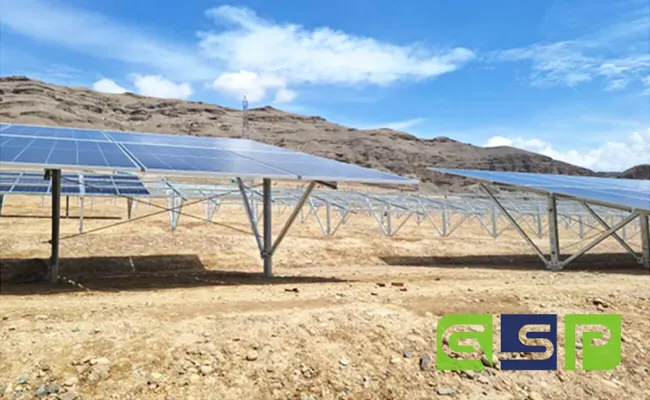
Destaque do projeto
ZMS uniu forças com Poder do Estado Verde (SPG), pioneira em infraestrutura de energia renovável, equipar um monumental 10 Projeto fotovoltaico MWP em Cabul, Afeganistão.
A ZMS analisou exaustivamente o projeto fotovoltaico e forneceu-lhe 1Cabos solares X10 e 1X6 H1Z2Z2-K, 3Cabos X300 BT, 3Cabos de MT X300, bem como CAA 185/30 cabos aéreos. Complementando estes acessórios vitais, como conectores fotovoltaicos e caixas de ferramentas meticulosamente selecionadas.
O compromisso da ZMS com a qualidade e confiabilidade facilitou a instalação tranquila e a eficiência operacional, contribuindo para a infraestrutura energética sustentável da região.
Serviço ZMS
Fabricação Personalizada
We understand that every customer's needs are unique. Portanto, oferecemos serviços personalizados de personalização de cabos solares, adaptando cada detalhe, desde especificações de cabos até interfaces de conexão, de acordo com os requisitos específicos do seu projeto, garantindo máxima compatibilidade e eficiência.
Logística Global de Resposta Rápida
Com o apoio da nossa rede logística global, A ZMS garante que seus pedidos de cabos fotovoltaicos cheguem a qualquer canto do mundo com segurança e rapidez. Nossa equipe de logística profissional monitora todas as etapas do transporte para garantir a entrega pontual de suas mercadorias.
Suporte Técnico
ZMS's technical support team is always on standby. Quaisquer que sejam os desafios técnicos que você encontrar, podemos fornecer respostas rápidas e soluções profissionais, garantindo uma experiência de usuário sem preocupações.
Produção Verde
Nossos cabos e acessórios solares cumprem rigorosamente os padrões ambientais durante o processo de produção, minimizando seu impacto no meio ambiente. Ao escolher ZMS, você não está apenas investindo em cabos fotovoltaicos de alta qualidade, mas também contribuindo para o desenvolvimento sustentável do planeta.

